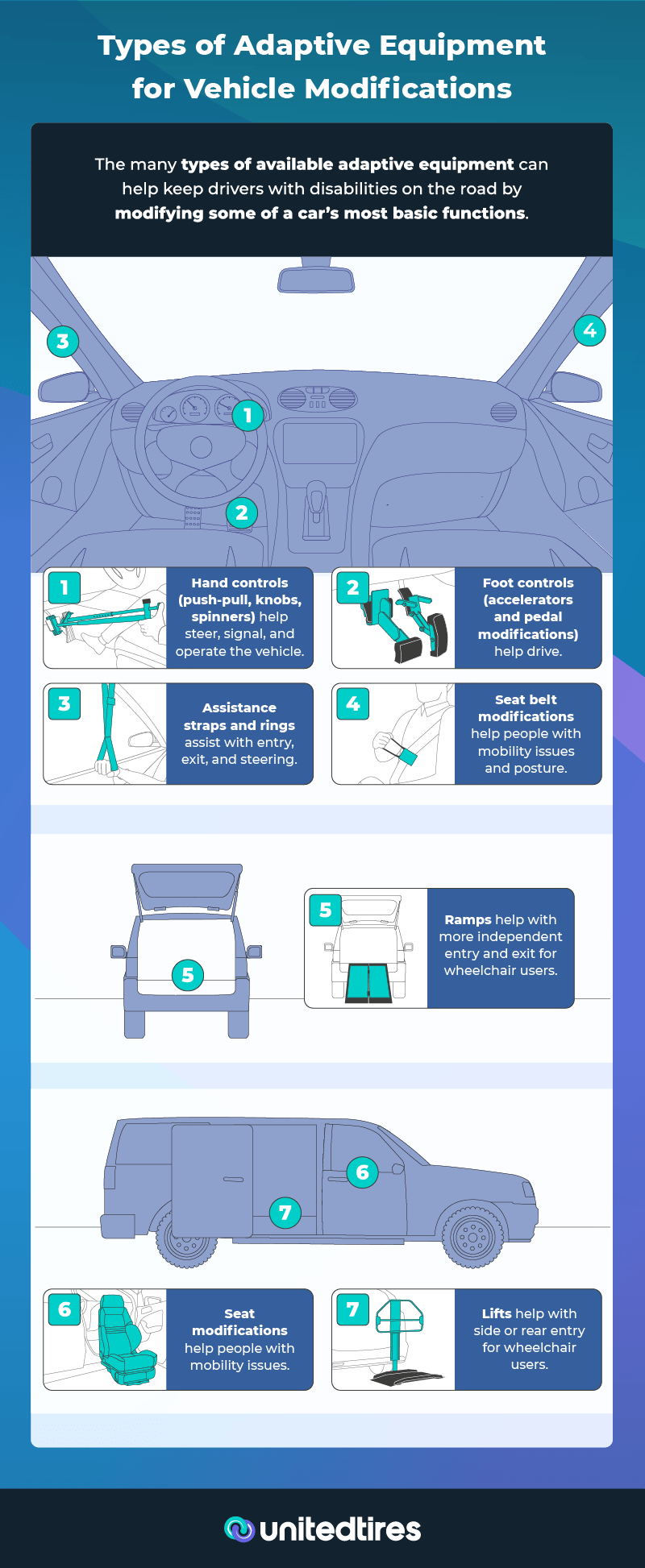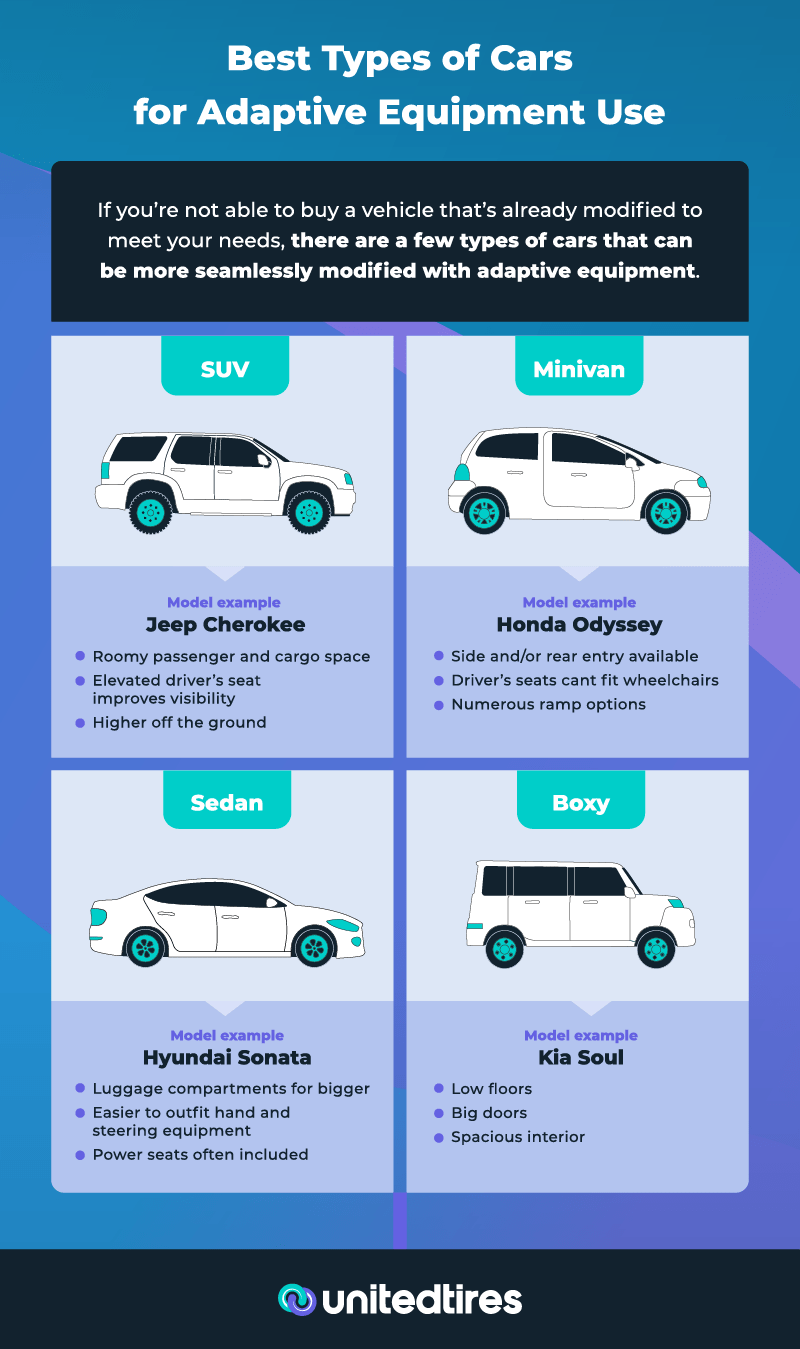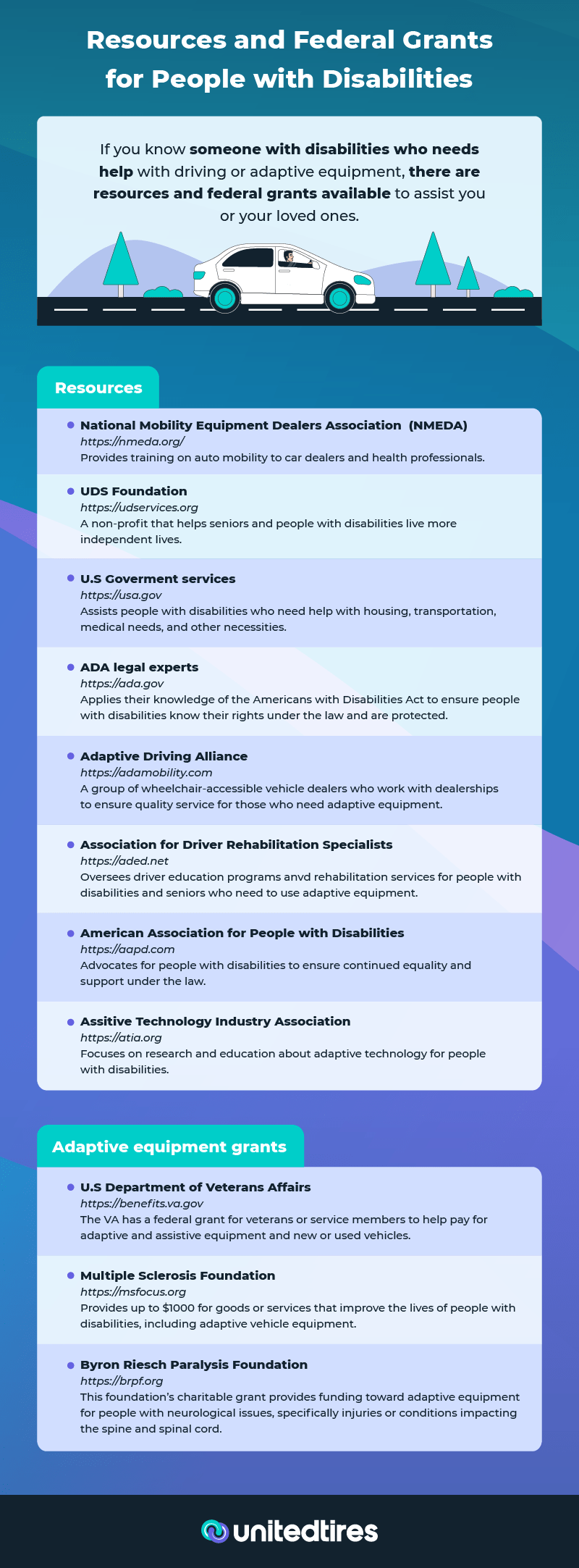There are many options when it comes to adapting and modifying a vehicle. From chair lifts to hand controls, there are modifications for nearly every need.

Accelerators and Pedal Modifications
There are many accelerators and pedal modifications to assist people with disabilities. These modifications can help:
- Increase range of motion for people with limited mobility
- Allow people to use their left foot instead of their right foot to control the petals
- Extend the pedals for those whose legs are unable to each
Assistance Straps and Amputee Rings
To help drivers with entering or exiting the car, assist straps are a worthy option. These devices strap around a vehicle’s window frame through a front or back door. Drivers or passengers can then use these straps to pull themselves up and out of the vehicle.
Assist straps are only to be used before the vehicle is started. They must be removed from the frame before driving begins.
Amputee rings are another form of simple car modification. They are designed for drivers with below-elbow amputations. The rings clamp onto a steering wheel. The driver then attaches their prosthetic to the wheel for steering.
Hand Controls
Hand controls allow drivers to control the vehicle’s acceleration and braking with just their hands. Controlled by a hand lever, these mechanical systems attach to the foot pedals. Typically, these controls are operated by the left hand. The right hand steers, shifts, and operates the car’s other systems.
There are many styles of hand controls:
- Push-pull systems work by pushing or pulling a lever to brake or speed up.
- The Right Angle system is similar to standard push-pull controls. It differs in that the pulling motion has been replaced with a right-angle turn. This makes it easier to move the handle.
- Push-rock levers are designed for drivers with little to no use of their fingers. When the driver pushes the handle forward, the vehicle brakes; when he rocks it backward, the vehicle accelerates.
Ramps and Wheelchair Lifts
Ramps and lifts are perfect for drivers that use wheelchairs and scooters. As the name suggests, these devices will lift and secure a mobility device inside or onto the vehicle.
There are both occupied and unoccupied lift systems.
- Occupied systems are designed to lift mobility devices that the person doesn’t leave. In these systems, the mobility device is secured onto the lifting platform with manual or automatic tie-downs. The driver then controls the lift to bring the device and driver into the cabin and ready to drive.
- Unoccupied systems include hoists and platform lifts. Hoists keep the mobility device locked on the outside of the vehicle. Once attached to the hoist, the wheelchair or scooter is lifted off the ground. It’s then secured on a rack or platform on the back of the vehicle. These are often used for scooters or for drivers who wish to keep their car’s interiors free of their mobility devices.
A similar system is used with ramps and docking systems. Instead of using a lift to bring a device and driver into the car, the mobility device is driven up a ramp. There, it then locks into the docking station. These systems are often used with power-operated wheelchairs. They can then act as a standard vehicle seat once secured in place.
Seat and Seat Belt Adjustments
Adaptive seat modifications can be used to assist drivers in and out of a vehicle. Powered transfer seats can swivel, rotate, and lift in many directions. This allows drivers to easily transfer into their seats. Some seat adaptations will even extend out of the vehicle and allow a driver to easily get into the seat. Then, they retract the seat back into the vehicle and the driver is ready to go.
There are options for people with limited ability to transfer out of a wheelchair. Wheelchair restraints and docking systems can secure the wheelchair to the floor of the vehicle. Once secured, it is locked in place like a standard car seat.
Seat belt adjustments are also popular. They include torso restraints and lap belts for extra safety.
Steering Wheel Adjustments and Knobs
There are many steering adjustments that make it easier and safer for a person with disabilities to drive.
- Steering knobs: These range in size, shape, and design to suit any need. Common styles include spinner knobs that easily fit in the hand and allow for a gentle grip to steer the wheel. Modified knob styles include pins, handles, and palm grips.
- Lightened power steering: This makes the steering wheel easier to turn and helps to reduce pain and fatigue when steering. These systems work well in tandem with other devices, such as steering knobs or handles.
There are also complete steering system redesigns. They can include foot-operated steering wheels, joysticks, and even acceleration/brake control. These systems can be customized to a drivers’ comfort and their specific abilities, but they are often the most expensive option.
Average Costs of Adaptive Devices and Vehicle Modifications
Adapted vehicles allow people with disabilities to drive with improved safety and comfort, but some of these systems can be pricey. In fact, it can cost upwards of $80,000 for a new, adapted vehicle. There are assistance programs that can help reduce these costs, but it is beneficial to look at the various options for each system. A driver will have to determine which modifications work best for their driving situation.
Larger modifications, such as lifts and ramps, will always cost the most — sometimes more than $30,000. But many drivers will be able to use cheaper devices, such as steering knobs and specialized seat cushions. These assistive devices will make their vehicles accessible and safe to drive for under $100 in some circumstances.
It is also important to keep in mind the continued costs associated with vehicle modifications. The added weight to the car will increase the wear and tear on the tires. Routine car maintenance will help ensure the vehicle is in top shape and that the modifications are functioning as intended.
| Modification | Price |
|---|---|
| Accelerators and pedal modifications | $100-$1200 |
| Assistance straps | $10-$50 |
| Amputee rings | $80-$400 |
| Hand controls (push-pull devices) | $150-$1500 |
| Scooter and wheelchair lifts | $1500-$4000 |
| Scooter and wheelchair ramps | $500-$30,000 |
| Seat belt adjustments | $30-$400 |
| Seat adjustments | $10,000 |
| Steering wheel knobs | $10-$300 |
Disclaimer: This data is an average of available products from a variety of manufacturers. It is meant to give an idea. Every person, vehicle, and specific accessibility need will be unique. As such, expect the cost of equipment and installation to vary based on the manufacturer, item need, or even the type of vehicle involved.
Manufacturer Discounts and Rebates for Adaptive Equipment
Fortunately, there are plenty of manufacturer discounts and rebates for adaptive equipment. Many vehicle manufacturers offer up to $1,000 reimbursement for the installation of adaptive equipment. Meanwhile, different equipment manufacturers can provide similar rebates on the equipment itself.
Those looking for adaptive equipment should shop at a medical equipment provider. These vendors often participate in Medicare and Medicaid and work with state programs that provide financial help for assistive technology.
Alternatively, used equipment is often much cheaper than new. Many programs and tools exist to help people find the specific equipment they may be looking for. But, as with any second-hand equipment, buyers must do their due diligence. Often, warranties won’t carry over to a new owner. Be sure to have any piece evaluated by a professional before purchasing. And make sure the items work with your existing vehicle.

